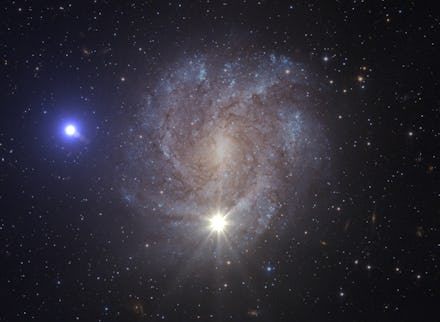These high-speed stars seem to defy laws of physics. Now scientists have an explanation.

Astronomers may have figured out the key to a select group of about 20 stars that previously stumped them. These stars, called hypervelocity stars, are racing through our Milky Way galaxy as fast as 2.7 million miles per hour. That’s fast enough that they are on track to actually break out of the galaxy — and so fast that scientists couldn’t figure out how these stars existed.
The Milky Way itself moves pretty slowly, and so does most of what’s in it. There are a couple ways a star can pick up speed within the galaxy: have a stellar partner explode and send it racing away, for example, or get shot away from its partner by a giant black hole like the one at the center of the galaxy. But those explanations didn’t seem to be able to cover every super-speedy star astronomers were seeing.
A paper published online in April that will appear in the August issue of Monthly Notices of the Royal Astronomical Society offers a new theory. Its authors latched onto a coincidence previous researchers had noticed about the very fastest stars: They aren’t spread evenly across the sky. Instead, there’s a cluster of them around where we see the constellations Leo and Sextans.
By focusing on where the hypervelocity stars are found, the team was inspired to turn to another galaxy, the Large Magellanic Cloud. It’s one of the galaxies closest to our own, and while it’s just one-tenth the size of the Milky Way, it moves very, very quickly, orbiting our galaxy at almost 250 miles per second. Unlike the Milky Way, it can also support close pairs of very large stars.
Take those same mechanisms astronomers had been looking at within the Milky Way, look at giant stars and add 250 miles per second, and suddenly hypervelocity stars seem much more straightforward.
The researchers asked what it would look like if, in a pair of large stars in the Large Magellanic Cloud, one went supernova and booted the other out of the way. That model could explain both the speed of these stars and their uneven distribution — they scatter off the Large Magellanic Cloud as it traces its way around the Milky Way.
And while it’s still an educated guess right now, there’s actually a European mission gathering data right now that could help astronomers decide if this new explanation really solves the puzzle. Called Gaia, and it’s already spotting more super-speedy stars. If those are also found in Leo and Sextans, it will add support to the Large Magellanic Cloud origin theory.